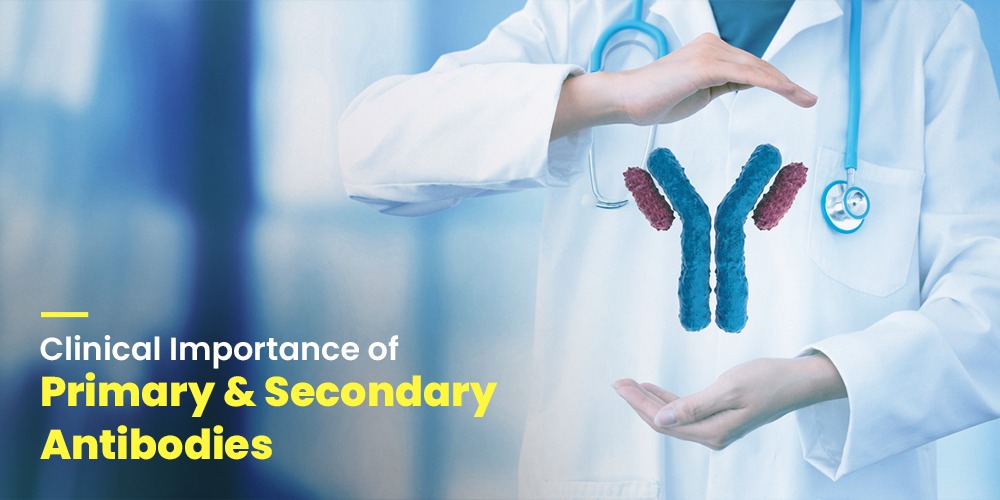Antibodies play an important role in the human body and also in various laboratory techniques, especially immunoassay techniques that involve the usage of antibodies to identify diseases and disorders from a given sample.
What are Primary Antibodies?
Primary antibodies bind to a specific antigen to recognize proteins and other biomolecules in a given sample like blood, serum, urine, or plasma. These antibodies hold diagnostic as well as therapeutic values and are effective in identifying cancer, diabetes, Parkinson’s and Alzheimer’s disease.
What are Secondary Antibodies?
Secondary antibodies bind primary antibodies in detecting target proteins. Secondary antibodies are available in different colours and offer increased sensitivity and versatility in labelling and detection, making them ideal for various applications such as flow cytometry, western blotting, and cell imaging. They enable colourimetric, chemiluminescent, and fluorescent detection of primary antibodies, providing enhanced sensitivity and flexibility in the visualization of target molecules.
Similarities Between Primary and Secondary Antibodies
Both primary and secondary antibodies can be widely employed in laboratory techniques like western blotting, immunostaining, and enzyme-linked immunosorbent assay for the detection and quantification of specific antigens in a sample.
Role of Antibodies in ELISA
ELISA uses different types of antibodies like capture antibodies, detection antibodies, and secondary antibodies to quantify specific antigens. The capture and detection antibodies i.e., primary antibodies bind to the target antigen, forming a sandwich complex while the secondary antibodies, if used, amplify the signal by recognizing and binding to the detection antibodies. This multi-step antibody-based approach enables the sensitive and specific detection and quantification of antigens in a variety of samples, making ELISA a valuable tool in research, clinical diagnostics, and other applications.
Trivitron Healthcare’s Contribution to Precision in Healthcare with ELISA Kits
HCV ELISA Test Kit:
The HCV ELISA Test is a highly reliable diagnostic tool specifically designed for the detection of antibodies to the Hepatitis C virus (HCV) in human serum or plasma. The kit contains all the necessary components required to perform the assay effectively like the 6-well microtiter plates that have been coated with HCV recombinant antigens, along with control reagents, wash buffer, conjugate buffer, and substrate solution.
The HCV ELISA Test boasts an exceptional sensitivity rate of 99.9%, ensuring a high probability of accurate detection, while also achieving a specificity rate of 99.8%. These outstanding performance metrics make it an excellent and dependable diagnostic tool for identifying HCV infection.
HIV Ab/ Ag ELISA Test Kit:
This highly reliable HIV Ab/ Ag ELISA diagnostic test is designed to detect the presence of HIV-1 p24 antigen and antibodies to HIV-1 and HIV-2 in human serum or plasma. The kit contains all the essential components required for the assay, including 96-well microtiter plates coated with HIV-1 p24 antigen, HIV-1 and HIV-2 recombinant antigens, and HIV-1 gp41 antigen. In addition, it provides control reagents, wash buffer, conjugate buffer, and substrate solution.
With a sensitivity of 99.8% and a specificity of 99.7%, this kit demonstrates excellent diagnostic accuracy for HIV infection. It is CE-IVD certified, meeting all necessary quality standards for diagnostic tests.
Syphilis Ab ELISA Test Kit: :
The Syphilis Ab ELISA Test is an in-vitro diagnostic immunoassay designed for the qualitative detection of antibodies to Treponema pallidum (Tp) in human serum or plasma. This test utilizes the enzyme-linked immunosorbent assay (ELISA) technique based on the double antigen sandwich principle.
The walls of a microplate are coated with recombinant Treponemal antigens, while other recombinant Treponemal antigens are conjugated with the peroxidase enzyme. When the test sample containing antibodies against Treponemal antigens is added, they react with both the antigens coated on the micro-walls and the antigens conjugated to the peroxidase enzyme, thereby forming a sandwich-like antigen-antibody-antigen enzyme complex.
The enzyme activity is then measured by adding a substrate that causes a blue colour to develop. The reaction is stopped using a stop solution, resulting in a colour change from blue to yellow. The absorbance of the developed colour is measured at 450 nm using a standard ELISA plate reader, with a reference wavelength of 620 nm.
At the outset, primary and secondary antibodies serve as critical components in the field of clinical diagnostics, enabling accurate identification and characterization of specific targets. They contribute significantly to advancing medical research, improving patient care, and ultimately helping to address various health challenges.

